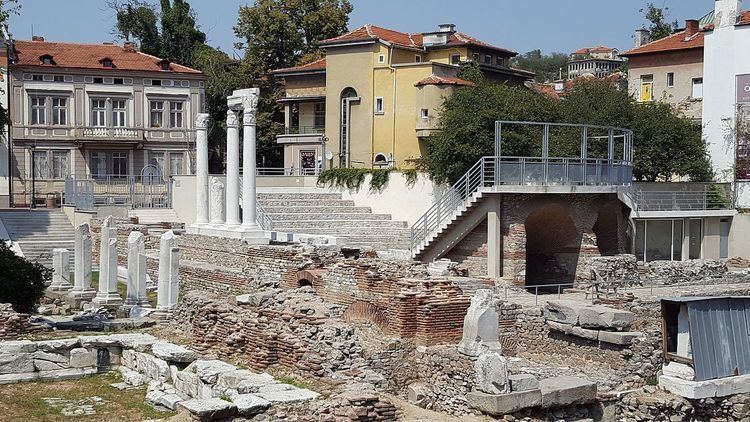Material bricks, marble, stone Abandoned 4th century AD Excavation date 1988 | Founded 2nd century AD Period Roman Empire | |
 | ||
Architectural style Ancient Roman architecture Similar Plovdiv Roman Stadium, Roman Forum, Nebet Tepe, Synagogue of Philippopolis, Plovdiv Regional Ethnogra | ||
The odeon of philippopolis plovdiv bulgaria
The Odeon of Philippopolis (Bulgarian: Одеон на Филипополис) was the house of the city council of citizens (known as bouleuterion) of ancient Plovdiv. It was also used as a theatre due to its appropriate structure. The Odeon buildings had four construction periods: from the 2nd century AD (during the reign of Hadrian) when it was initially built to the 4th century AD when it was abandoned. The existence of such a building in ancient Plovdiv is a sign for the importance of Philippopolis as a cultural and political center.
Contents
- The odeon of philippopolis plovdiv bulgaria
- Bulgaria hilites plovdiv the roman theatre
- Location
- The Odeon
- Conservation and restoration
- References
Bulgaria hilites plovdiv the roman theatre
Location
The Odeon of Philippopolis was discovered near General Gurko str in the Northeastern conrner of the Roman forum in Plovdiv. The natural connection between the odeon and the forum was destroyed during the construction of Maria Luiza blvd. and the tunnel under the main pedestrian street of Plovdiv.
The Odeon
The Odeon was a rectangular building which comprise typical elements for roofed theatres like skene, orchestra and cavea. The skene is narrow and its length spreads through the entire width of the cavea. The proskenion (the podium in front of the skene) was 1,5m higher than the level of the orchestra. The skene was two-stories high built in Corinthian order system of Roman type which was typical for the period . Typically for a theatre buildings, vertical grooves were found in the skene's wall which indicate that a structure for raising and lowering a curtain probably existed. The height of the construction that bears the cavea was considerable.
The orchestra had a horseshoe shape which was typical for Roman provinces. In the last construction period of the Odeon, however, size of the orchestra was reduced and its shape became semicircular. The floor was made of large marble slabs surrounded by marble orthostates near the cavea. A wall around the Eastern end of the orchestra supported the lowest part the cavea.
The cavea surrounds the Eastern side of orchestra and had between 300-350 spectator seats arranged in step-like shape for better visibility. A vaulted structure with numerous vaulted spaces in truncated cone shape supported the cavea. A similar structure was used for the construction of the spectator area of the Colosseum in Rome. The cavea is separated from the skene via parodoi.
Conservation and restoration
The Odeon of Philippopolis was discovered in 1988 by the archeologist Z.Dimitrov and Maya Martinova. In 1995 the ancient monument was listed as a cultural value of national significance. Conservation works were carried out in 2002 with the financial support from the Leventis foundation.
